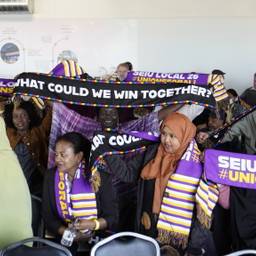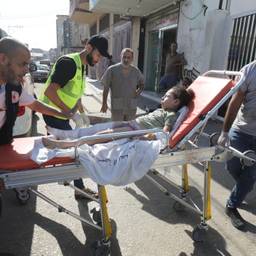The Most Important Labor Story Right Now Is in Minnesota—It Might Be the Model We All Need
A strategic alignment of major networks of unions and community groups in Minnesota have worked together for more than a decade to leverage their collective power.
Sarah Jaffe
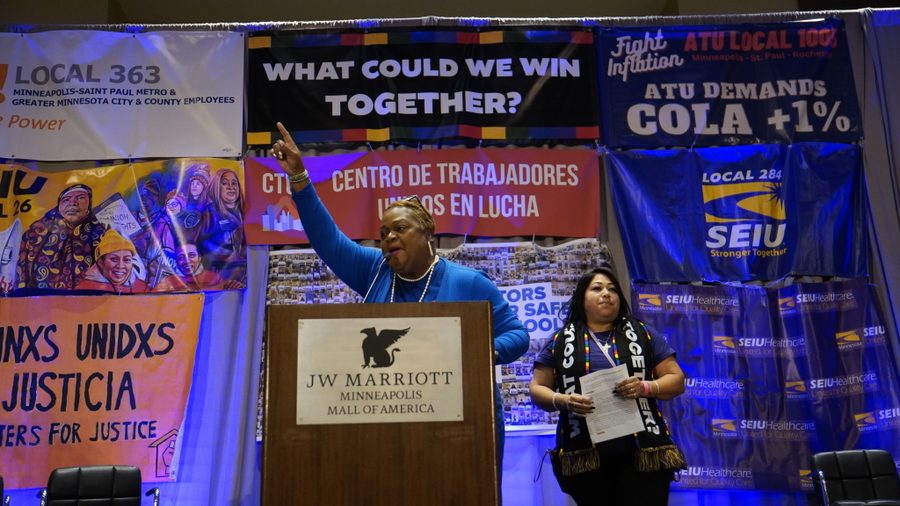
Lea este artículo en Español.
Andrea Villanueva was in bargaining five days ago, negotiating a new contract for herself and 500 other retail janitors who clean some of the Twin Cities’ most recognizable stores. A group of building security workers, also members of Villanueva’s union SEIU Local 26, were also in negotiations in the same building. The workers bumped into one another in the hallways as the day went on — stopping to cheer each other on and express their solidarity.
Local 26 is just one of a major network of unions and community groups in Minneapolis and St. Paul that lined up bargaining processes for new contracts — and in some cases, strike votes — around a March 2 deadline, deliberately set in order to maximize their leverage and win collectively-determined community demands around four key issues: dignified work, stable housing, a livable planet and good schools.
That deadline is today, and a rolling Week of Action that will likely include thousands of workers on strike, street protests, and art and theater events, is set to begin.
In this collective effort, Local 26’s 8,000 members are joined by thousands of others: teachers and school support workers, care workers from 12 nursing homes, parks and public service employees, transit drivers, construction workers, restaurant staff, and community groups organizing around housing and climate justice. Before March 2, 15,000 workers had taken strike votes and though some of them have settled, some 10,000 may still walk off the job this week.
They’re members of groups including SEIU Local 26, St. Paul Federation of Educators (SPFE), SEIU Healthcare Minnesota & Iowa, Amalgamated Transit Union (ATU) Local 1005, CTUL, Inquilinxs Unidxs por Justicia, Minnesota Federation of Teachers (MFT) Local 59, LIUNA Local 363, Minnesota AFL-CIO, UNITE HERE Local 17, AFSCME Local 3800, CWA Local 7250, Unidos MN, ISAIAH, and many more.
Coming together around the question “What could we win together?” this broad cross section of Minnesota’s working class decided to go on the offensive, developing a set of guiding principles over months, made possible in turn by years of relationship building through street uprisings and overlapping crises.
Shortly after we spoke that day, Villanueva and her colleagues felt that collective power manifest: reaching a tentative agreement with their employers after months of bargaining. The strike they’d authorized to begin March 4 would not be necessary: they won a 17% increase in base pay, an improved healthcare plan, more paid time off, and their first-ever paid holidays on Thanksgiving and Christmas.
The next day, the building security workers who were negotiating nearby on the same property, also reached an agreement, one that included pay raises of up to 27%, employer-paid 401Ks, and a Juneteenth paid holiday.
What is happening in the Twin Cities could be a powerful model for the working class everywhere: a movement ecosystem whose members show up in deep solidarity across differences, that thinks strategically and builds for the long term while maximizing its current power. That understands workers are also renters, neighbors, people who want a livable city and climate — and that they can exponentially amplify their power by acting together.
“We have learned over and over again,” Local 26 President Greg Nammacher explained, “when we try and push for justice in each of our own separate lanes, we are not as successful as if we push for justice together across our different organizations.”
“In a way it’s fun, to be all together,” Villanueva told me.
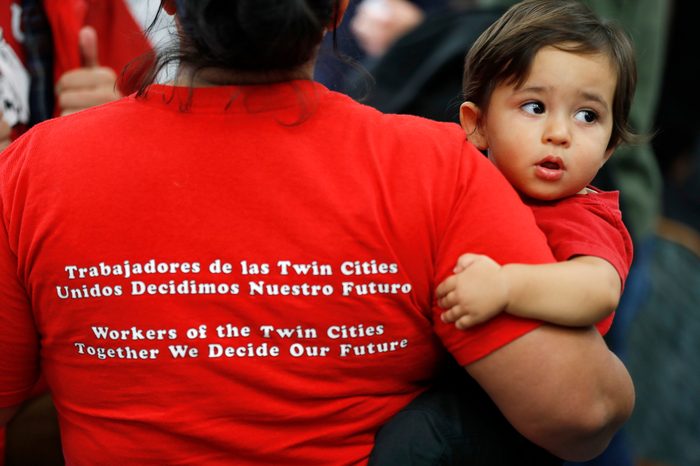
Villanueva has been working for a company called Carlson Building Maintenance for almost 16 years, and for the last six years she’s been cleaning one of the upscale Lunds & Byerlys grocery stores. She made just a little over minimum wage ($16.07 an hour when the city’s minimum is $15.57) and struggled to pay for health insurance — and her costs have been steep.
When Covid first hit Minnesota, she told me she contracted the virus and had to be intubated. “They say because of that I have some holes in my lungs. And right now, when I’m working, I feel like sometimes I’m out of breath,” she said in Spanish. “After having Covid, you are not the same.” She was out of work for four months and the only support she got, she said, was from the union. The company “called us heroes and essential, but during that time they never help.”
A lot rides on her ability to stay healthy. Villanueva and her husband are supporting her parents back in Mexico, as well as her daughter-in-law and seven-year-old granddaughter, of whom she speaks proudly: “She’s very good at school. She says to me that when she grows up, she wants to be a doctor.” Better health insurance will go a long way for her, and she’s also pleased to have paid holidays for the first time.
“Our membership has gone through so much difficulty in the last years, being essential workers on the frontline of the pandemic. And now to see these breakthroughs on things like retirement and pay is just so meaningful for the folks who have sacrificed so much for these industries,” Nammacher said. “So we are very proud of the steps forward, but we absolutely are also clear: these are just [some] of the steps that are needed to really improve our community.”
Debates about political and union organizing often revolve around finding the one true and proper model that would work for everyone. But the Minnesota unions and community organizations who set this March 2 deadline show that such arguments are often asking the wrong questions. Rather, their model is many models at once.
Partly because what makes this strategy powerful is its multiplicity, it can be hard to write about in simple terms. By moving in alignment rather than lockstep, these unions and community groups have been able to influence powerful decision makers in politics and the private sector who might otherwise have dismissed them, while experimenting with a variety of tactics as they go.
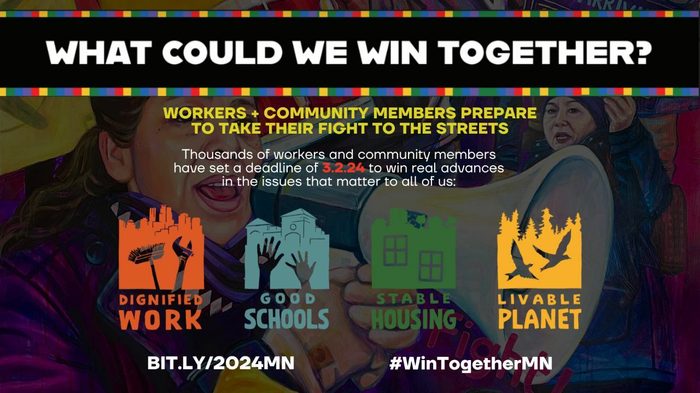
Rather than trying to shoehorn everyone into one way of acting, the groups in this alignment are thinking and acting, as Rodrigo Nunes terms it in his book Neither Vertical nor Horizontal: A Theory of Political Organization, ecologically. Organizing this way, Nunes suggests, means “privileging cooperation over competition, nurturing common resources and mutually beneficial relations, and strategizing with a broad field of other agents in mind.” It means asking how organizations can complement each other, rather than compete for resources or demand 100% consensus.
“We’ve had to figure out how to work together in new and different ways, always respecting each organization’s autonomy,” Nammacher explained. “But by doing that hard work of coordination across those sectors, across those unions, across community and labor … we can really achieve something that’s far more than if we were doing it by ourselves.”
This network of relationships in Minnesota has been built slowly and methodically over the past decade, as unions increasingly lean into social movement strategies and community groups were founded and flourished at the intersection of labor, immigrant rights, and racial justice organizing.
“For too long, I think the labor movement has made the mistake of letting ourselves get isolated and focusing as if negotiations are just about moving forward for a small club of people,” Nammacher said. “And I think it is critical for a powerful labor movement to stand shoulder-to-shoulder with other unions, with other community organizations, because that is the only way that we are going to become visible.”
One of the earliest partnerships in this ecosystem was between Local 26 and Centro de Trabajadores Unidos en La Lucha (CTUL), a worker center primarily organizing in Latinx communities. Following the model of the celebrated SEIU Justice for Janitors campaign, they successfully organized cleaners at Target and other big box stores into the union, using pressure on the companies at the top to demand better standards of the subcontractors — cleaning companies like Carlson, where Villanueva works. Since then, and recently, CTUL has built on that model and collaborated with the North Central States Regional Council of Carpenters and other building trades unions to put in place a similar model in the construction industry, where immigrant workers are similarly exploited.
Douglas Guerra is one of those construction workers. He’s been in the industry for 16 years, and, he said in Spanish, “Whether it was paid by the day, paid by the hour, or working as an independent contractor, the common thread has been that there’s been wage theft through it all.” It was this rampant wage theft that led him to CTUL, which helped him recover some of his missing pay. “It just seems like the system is built for supporting the bosses and not workers.” He decided to stay on and help support other workers.
During the upcoming Week of Action, he was looking forward to learning sessions in a “leadership school” with other workers, to share stories about their campaigns, and to leading an action calling on developer Solhem to join the Building Dignity and Respect program.
“I just want to make just a very clear message for everyone to know that we’re not alone,” Guerra said. “It doesn’t matter your race, it doesn’t matter your gender, it doesn’t matter where you’re from. We all have the right to stand up and fight.”
Estela Tirado, a restaurant worker and mother who works in downtown Minneapolis, is also a member of CTUL and, like Guerra, also reached out because her wages had been stolen. She has been involved with CTUL for two years, and was part of planning an action to push for the city of Minneapolis to create a labor standards board. Two days after today’s March 2 deadline, on March 4, she will testify before the City Council about why the board, which could help regulate industries that are hard to organize, like hospitality, is so necessary. Many workers in restaurants, Tirado said in Spanish, “are afraid to speak out about their rights because what would you do without a job then? But I think it’s important that we stand up, we have to speak out.”
The standards board and the Building Dignity and Respect program are just two examples of ways non-union workers can win power and make an impact beyond their own workplace. They are what Nunes called “strategic wagers,” attempts at envisaging and enacting plans for achieving transformation that may not always succeed but provide replicable models for innovation that can be iterated upon. The program is new; the standards board doesn’t yet exist, but whether each ultimately succeeds or fails will teach CTUL and its partners something about their overall direction and which tactics to try next.
Thinking ecologically about movements doesn’t have to mean thinking about the climate crisis, but climate is one of the four focuses of the Minnesota alignment, says Unidos MN, another partner organization which has roots in the DREAMer movement and has focused on environmental justice. One of their key demands, according to lead climate organizer Ulla Nilsen, is “a block-by-block clean energy transition for residences” and that this block-by-block transition would mean clean energy jobs would be union jobs. Unidos MN members are very familiar with the lousy conditions of construction work described by Guerra, and they want to ensure that green transition work is better work.
Beyond the question of jobs, though, they are also thinking about how the transition can improve people’s everyday lives. “We want to make sure that every Minneapolis resident has access to healthy, clean energy in their homes, because … one of the biggest pollutants are buildings in Minnesota,” explained Lupe Tejada Díaz, a leader with Unidos MN. “And so in order to make sure that we have healthier air and just healthier places to be, we have to start at home.”
Many of the recent immigrants in the Twin Cities, Díaz said, are themselves climate refugees, and so see the benefit of climate mitigation work as a way to be involved in “the prevention of having the climate crisis escalate any further to displace them once again.” And so Unidos MN is bringing together members who have worked non-union jobs with renters and other members of the Just Transition Fund Coalition as part of this Week of Action, highlighting their victories in securing public funding for climate equity and making demands for more. If, Nilsen said, federal policy follows state and local, then a city like Minneapolis “can create a model that then can be an inspiration for other places and seeing, even if you didn’t care about climate, this is cost savings. This is addressing long standing racial disparities. This is providing a healthier ecosystem, social ecosystem for the city.”
The movement ecology that has made all this possible, that is demonstrating its power this week, Díaz said, is providing a renewed sense of hope for the community.
The diversity of the organizations — in membership and in purpose — that are part of the alignment in Minnesota, Nammacher said, are also part of their strength. “We actually represent an incredible crosscut of society. At night when we’re at 2:00 a.m. when we’re negotiating, trying to find a settlement, we have hip hop, country, traditional music from East Africa, salsa [playing].”
It’s an ecosystem that I have been following since the days of Occupy Wall Street and its Minnesota spinoff, Occupy Homes. When I wrote about Occupy Homes in my first book, Necessary Trouble, Cat Salonek, executive director of the Tending the Soil coalition that includes Unidos MN, Local 26, CTUL and others described Occupy as “a dandelion that got blown into the wind.”
Those seeds grew into new movements, new organizations, which, in turn, then blew back out again and launched new efforts. Salonek later also suggested that social justice organizations and unions can hold movement energy, like a tide pool holds water and incubates life between high tides. “After Occupy Wall Street or after Black Lives Matter, that tidal wave washes the nation and then goes back out and we try to contain as much of that as we can. We train and we develop, and when the next wave comes, we’re that much bigger and that much stronger, and we can push it so much further and capture more as it washes back out.”
Salonek was with Tending the Soil when I visited Minneapolis in May 2023, and she introduced me to two other member organizations in that coalition: New Justice Project, a Black-led organization working with formerly incarcerated people and in low- and no-income communities, and Inquilinxs Unidxs Por Justicia (United Renters for Justice, or IX). IX also sprang, dandelion-like, from Occupy Homes, and its members are also taking action this week. Its founders, Jennifer Arnold and Roberto Edward de la Riva Rojas, wanted to build a tenant union that could go head-to-head with the city’s most powerful landlords.
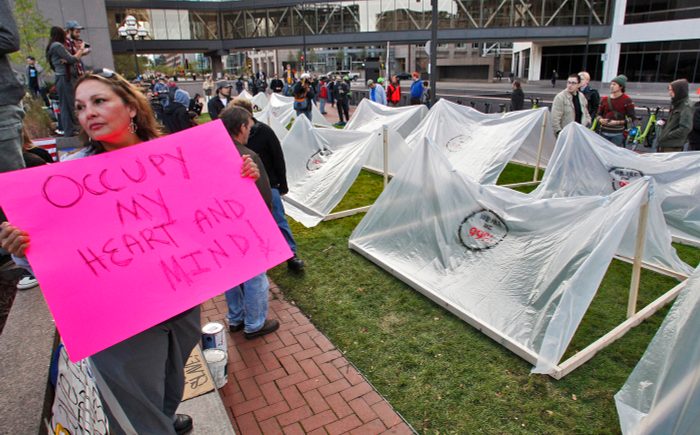
In a 2021 article in The Forge, de la Riva Rojas wrote that the “campaign that began in tenants’ kitchens and living rooms ended up winning more than $13,000,000 in collective wealth for tenants, stopped more than 1,000 evictions, and put affordable housing on the map in Minneapolis. The campaign culminated in the landlord selling us five buildings to create the ‘Sky Without Limits’ housing cooperative.”
For IX, Arnold told me last spring, autonomy is a key value. “We feel like we have a valence on it that is about, ‘How do we take this and run it for ourselves?’” Democracy is meaningless if the working class isn’t building it for itself. The Sky Without Limits housing cooperative is one part of this process, and while IX is still organizing tenants, it also has its eye on another prize: social housing.
Alibella Rodriguez has been involved with IX since when its organizers knocked on the door of her apartment some seven years ago. She’d been dealing with what IX organizers think of as “the cycle,” where landlords refuse to do repairs, blame tenants for things like roach infestations, and then when they face any consequences from the city or the courts, they either evict people or sell the building. She called IX when she got an eviction notice in the middle of a Minnesota winter. She and her neighbors decided to fight.
Things have gotten better since their court case, Rodriguez told me through a translator. “The landlord is a little bit better. It takes time to make repairs, but he does the repairs.” But so many people she knows are still going through the cycle. So, in this Week of Action, she’s taking part in a forum with the county commissioners to discuss social housing.
“What we want to do is start these conversations with the county so they can buy properties and own it,” Edain Altamirano, an organizer with IX, explained further. What they want is locally controlled social housing, that is accessible for everyone, regardless of income or immigration status, and that is democratically run. “People who live in the property can decide about what is needed and make a commitment about how we going to maintain it and how we going to reproduce that.”
Being part of the alignment, Altamirano said, is about making it clear that housing is everyone’s issue, that workers all need decent housing, and if that keeps going up, any raises at the bargaining table vanish into rent. Tenant unions that target particular landlords work in a similar fashion to a labor union: they organize the people who have been chosen by capital (the landlord, the employer) rather than self-selected. This kind of organizing is harder, in many ways, but the organizers in Minnesota are showing what is possible when you do it well.
Minneapolis was Ground Zero of the George Floyd rebellion; this everyone in the country probably knows. What people likely don’t know, however, is that Floyd was killed just down the block from the office building CTUL shares with IX, which became a critical movement hub during the uprising for everything from food distribution to a safe space from the teargas.
About five years before Floyd was killed, Minneapolis police killed Jamar Clark and activists responded by occupying the Fourth Precinct for two weeks. Relationships built during that occupation would spill over into more organizing when Philando Castile, a St. Paul school cafeteria supervisor, was killed by a police officer in a St. Paul suburb in July 2016. Castile was beloved by students at the school where he worked, and his death spurred the teachers unions into action: during the summer of 2016, when the American Federation of Teachers held its annual convention in the Twin Cities, the St. Paul Federation of Educators (SPFE, then the St. Paul Federation of Teachers) helped organize a march that led to the occupation of the street outside of US Bank’s headquarters and 21 arrests. At the time, I wrote that this was “a rare moment where union members challenged the police as union members.”
The breadth and depth of the George Floyd rebellion was helped along by a movement ecosystem in the Twin Cities that had built trust and relationships that could hold up through the flames and gas. CTUL and others did not start or lead the rebellion but they provided space and support as it unfolded, and Minnesotans had built up their understandings of police violence over years in part through protest and direct action that lent strength to the uprising. As Nunes noted, “However improvised and spur-of-the-moment a demonstration or a riot is, it never truly corresponds to the myth of a multitude of unconnected individuals joining together all at once, like a crowd in a musical magically breaking into song.”

“You have to keep rebuilding that trust,” Greg Nammacher said. “You can’t take the past for granted. All of our organizations see a lot of change, and as new members and leaders come into the organizations, which is a healthy, great thing, but it does mean that we have to recreate the opportunities for organizations to rebuild and deepen that trust as we think about more and more ambitious fights.”
Minneapolis Federation of Teachers (MFT) vice president Marcia Howard was also deeply involved in what became known as George Floyd Square, and racial justice was key to the MFT’s strike in 2022, the first major teachers’ strike of the Covid era and one in which the SPFE and MFT had coordinated their strike deadlines for a potential two-city-wide schools strike. The teachers and school workers focused specifically on the lowest-paid employees at the schools, who tended to also be workers of color. Ma-Riah Roberson Moody, a special education assistant at Minneapolis’s Roosevelt High School and the first vice president of the Educational Support Professionals chapter of the MFT, told me at the time, “We have these shared issues, especially across districts. St. Paul has some things that they’ve bargained for, they went on strike, and we have admired some of the things that they’ve been able to secure through that process.”
This time around, the teachers are in bargaining at the same time once again. SPFE has authorized a strike, and MFT may as well if they do not reach a deal in their mediation process.
Shanaz Padamsee is a behavior intervention specialist at St. Paul’s online school and on SPFE’s bargaining team. The online school is only one of many specialized learning environments that St. Paul offers, Padamsee said, ranging from a new East African magnet school and other dual language schools to Montessori and International Baccalaureate schools.
“We have these teachers and educators who need to be very up on all these different ways of methods of teaching,” she said. “We want to make sure that we keep this talent in our schools.” But the district keeps low-balling them on pay and benefits — like nearly everyone I spoke to for this story, she worries about healthcare costs.
What Padamsee likes about being in SPFE, though, is that the union prioritizes more than just wages and benefits. “There’s a whole gamut of different things that the teachers are concerned with — how do we make our schools better? Not how do we just better our lives, but how do we better things for our students as well?”
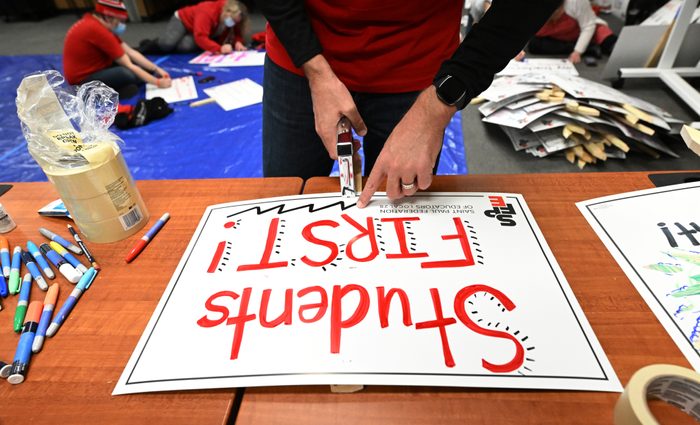
This is a strategy now known as Bargaining for the Common Good, which began with teachers’ unions, first in Chicago in their historic 2012 strike and then spreading to places like Los Angeles and St. Paul, where teachers have brought a variety of community demands to the bargaining table.
“Minnesota’s upcoming strikes and Week of Action start with the question of ‘What could we win together?’” Marilyn Sneiderman, the executive director of Center for Innovation in Worker Organization (CIWO) at Rutgers University, which incubates Bargaining for the Common Good initiatives with unions around the country, told me. “By engaging deeply with members from different unions and community orgs, developing demands that resonate broadly with workers and the community at large, centering racial justice and immigrant rights, Minnesota demonstrates how Bargaining for Common Good Campaigns can build the power needed to rebuild the labor movement, empower communities and win transformational change.”
The St. Paul teachers have won on issues like smaller class sizes and fewer standardized tests, and they have also created a groundbreaking restorative justice initiative in the schools. By organizing alongside students and parents, as well as the other schools workers in the Twin Cities, they have been able to win more in the schools, and keep the support of the community when they do strike. The motto of BCG in the schools has been “Teachers’ working conditions are students’ learning conditions,” and this week’s planned actions in Minnesota show us what it looks like to expand that philosophy to many more groups of workers.
Nearly all of the workers taking part in the Week of Action were so-called “essential” workers during Covid lockdown, and so, Nammacher said, one of the issues that helped solidify their alignment was a fight for essential worker pay at the state level. Another was rent stabilization, because, as Edain Altamirano at IX points out, every worker also needs a home.
But the trust they have built goes beyond policy goals, and that is in part, Nammacher said, because the movement has built spaces for working people to bring their whole selves, suffering and all, into the room. “Obviously that’s really hard, but over and over again, we have found if we create the democratic spaces for members to come and put their issues on the table and be heard and collectively make decisions about how we’re going to turn that personal pain into public demands, either on our government or on our employers, that people have an incredible capacity to find empathy in each other and to come together in incredibly powerful ways.”
He continued, “Only when we take the time to do that and to let people put that pain in the room and to work through that process and find that those places of common ground can we then fight together. Only when we do that are we able to stand together when it comes to the hard moments when the employers or the politicians will try to divide us. If we haven’t done that work, we are much more vulnerable to that division.”

Key to bargaining for the common good strategies is the strike, though. It is the place where workers have maximum leverage, and where they can bring that leverage to bear on a variety of issues that have not been considered valid subjects for bargaining. (And, I might add, that a swath of the Left often dismisses as not real workers’ problems.) Local 26 has even held the nation’s first union-authorized climate strike, winning wage increases and funding for green cleaning education.
And so, when Padamsee and I spoke, she was preparing for a potential strike on March 11.
Not every strategic wager will be a win, but there is something to be learned from the losses, and trust can be built through honestly facing them. The campaign to replace the Minneapolis Police Department with a department of public safety failed, but, JaNae Bates with interfaith justice group ISAIAH noted, organizations including ISAIAH and the New Justice Project learned from that effort where and how to concentrate their organizing.
Each attempt, even the ones that fail, teaches useful skills that then get rolled into the toolbox of the movement ecosystem. Building toward today’s March 2 deadline, Nammacher said, “we’ve had multiple trainings of over 150 frontline leaders and rank-and-file members from across the different unions and community organizations. We had a thousand people together in October.”
Internal reform within the unions and organizations also plays a role.
AJ Lange is the new business manager of LIUNA Local 363, which, he told me, had been “a sort of sleepy local that had never done a lot of the rank-and-file organizing.” Members tended to treat the union as a vending machine rather than an organization to build and use collective power. But now, public works employees with the city of Minneapolis, members of the local, voted 99% to authorize a strike as part of the collaborative action, potentially as early as March 5. MFT and Local 26 brought them into the alignment and supported Lange as he learned the ropes, and, he noted, it actually made a lot of sense for his union to be involved.
Local 363 represents some 1,000 public sector workers in the Twin Cities and surrounding area, the workers who, Lange said, are “unsung heroes, the backbone, glue of holding the city together, making it function.” They are the workers we often forget about until something breaks: they maintain sewers and water treatment, street maintenance, sanitation, parks, and more. Wages are a key issue for them as they are for, well, everyone, as is staffing, but they also have some deep interests in the other issues at hand.
His members, Lange said, had been called in to clean up after the Uprising, and to clean up when the city evicts homeless encampments — something that wouldn’t be a problem if the city took justice and housing seriously. “This is a failure of city leadership and planning and a number of different actors involved in the decision-making process,” he said. “That is a problem that we are really truly on the front line of what the negative outcomes are, and we deal with it in our personal lives too.” The city, he noted, is “paying wages that put them in that position where they would be struggling to be able to find affordable housing.”
When it comes to the climate crisis, Local 363 has an interest there too, Lange said. They are responsible for maintaining trees and green spaces in the city, and the storm water system too. And they maintain the recreation centers, the parks where kids play when they aren’t in school. “We are a part of the good schools broader component too,” he said. Their work does so much to maintain what he called “a livable community too, a place to grow and to be a family and to provide a decent life that we all deserve.”
Looking past this week’s upcoming actions, it’s worth noting that the United Auto Workers recently invited other unions to coordinate their contract expirations with the end of the UAW’s Big Three contracts, on May 1, 2028. What’s happening in Minnesota right now is some indication of what it might look like for unions, community groups, and social movement organizations working on climate and racial justice to align their goals broadly and tie them to the potential for multiple strikes. It is an ecology where working people have built up their collective capacity over the course of years; it reminds us that coordinating strike action is not as simple as picking a date, but also that picking a date can give the working class a target around which to build.
Today’s March 2 deadline, Nammacher said, has already paid off: workers winning raises of 17%, 20%, 22%, getting holidays and affordable healthcare for the first time. And there is more to come.
“Obviously we have only begun, the vast majority of both our members as well as the other coalition members, still have not found settlements. If it does become necessary, we are obviously very ready to strike,” Nammacher said.
Thousands of workers in Minnesota will be in the streets next week, demanding labor standards boards and fair construction work, social housing and climate preparedness, schools for all and healthy parks and trees.
What else, after this demonstration of power, could they accomplish together?
This article is a joint publication of In These Times and Workday Magazine, a nonprofit newsroom devoted to holding the powerful accountable through the perspective of workers.
Sarah Jaffe is a writer and reporter living in New Orleans and on the road. She is the author of Work Won’t Love You Back: How Devotion To Our Jobs Keeps Us Exploited, Exhausted, and Alone; Necessary Trouble: Americans in Revolt, and her latest book is From the Ashes: Grief and Revolution in a World on Fire, all from Bold Type Books. Her journalism covers the politics of power, from the workplace to the streets, and her writing has been published in The Nation, The Washington Post, The Guardian, The New Republic, the New York Review of Books, and many other outlets. She is a columnist at The Progressive and In These Times. She also co-hosts the Belabored podcast, with Michelle Chen, covering today’s labor movement, and Heart Reacts, with Craig Gent, an advice podcast for the collapse of late capitalism. Sarah has been a waitress, a bicycle mechanic, and a social media consultant, cleaned up trash and scooped ice cream and explained Soviet communism to middle schoolers. Journalism pays better than some of these. You can follow her on Twitter @sarahljaffe.
